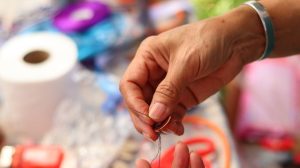The idea of clothing came about not out of demureness, but out of a necessity to protect one’s body from the harmful effects of extreme cold temperatures. At first, archaic humans around 60,000 years or so ago, simply wrapped themselves with animal skins or furs. Later they found it more practical to tie the fur wraps with strong vines or strips of animal skin.
In geographical locations where snow and freezing temperatures were more life-threatening, early humans thought of ways on how to make their animal wraps more secure. A secure animal wrap is important when going out to hunt or gather food amidst the biting cold.
The Invention of Awls and Needles
Much later, by around 45,000 BC, someone thought of poking holes on the animal hides, using sharpened pointed sticks or stones. Cords, leather strips or strong twines could run through the holes, then drawn in order to fasten pieces of animal hides or fleeces together. Today, modern people use tools called awls (olls), similar to the the sharpened pointed objects devised by prehistoric people,
Then somebody from the 40,000 BC era, came up with a better idea of putting a hole in a primitive awl. Strings or cords were then inserted through the hole of the awl, which made the process of binding animal hides together, much easier and faster. That primitive invention is what came about as modern day needle.
Next Stages: Spindles, Threads and Fabrics
As groups of people had also learned to trade by barter, the idea of bone needles had spread far and wide in Europe and in North America. Much later, spindles and whorls were invented to make the supply of strings or cords more manageable. Early man’s invention of a crude spindle led to the development of ways to create finer types of fasteners derived from plant fibers. Modern times refined strands into sewing materials we now call threads.
In 9,000 BC in West Asia, the advent of finer types of fibers extracted from plants, led to the development of a process of interlacing strands in order to create lighter, softer and thinner materials. At that point, the early people wove fibers that served as floor mats and blankets used as additional warmers during cold seasons.
Woven materials were expensive as it took some time before a large piece can be completed. Still, as people advanced into becoming civilizations, weaving fabrics became part of a culture. Weavers in different regions devised systems for incorporating artwork, using natural colors of plants as pigments. Fabrics then became a way of determining and distinguishing a race or culture.
Moreover, scholars took to studying ways on how woven fabrics can become much softer and smoother, specifically for the higher members of the echelons; also as a way of distinguishing their rank or level within a civilized society.
Clothing Became a Fascination, which Led to the Birth of Fashion
At first, clothes were mere pieces of soft fabrics sewn together at the sides, had provisions for neck and arm holes and were called tunics. To make them ornate, and look more sophisticated, additional fabrics were either tied, draped, pinned, or sewn on a tunic. As ideas flourished on how to make clothes more attractive, wearers started developing a fascination for clothes, wanting every new creation better than previous piece.
In time, there was no limit or boundaries on how many pieces of fabrics were used, especially if to be worn in colder climates,. Back then, the important thing when making clothes for the elite is to assemble clothing materials into garments that made them look more impressive or better yet, more attractive. If a certain style drew positive attention, then that style was set as the latest fashion.
 Somehow amidst a fascinating world full ofdigital creations, making things by using traditional sewing skills can bring a different kind of fulfilment to the creator. Actually, learning how to sew has never lost its popularity because it’s a transformative hobby that brings out the simple joys of crafting using your own hands and some basic sewing tools, including a conventional sewing machine.
Somehow amidst a fascinating world full ofdigital creations, making things by using traditional sewing skills can bring a different kind of fulfilment to the creator. Actually, learning how to sew has never lost its popularity because it’s a transformative hobby that brings out the simple joys of crafting using your own hands and some basic sewing tools, including a conventional sewing machine. Sewing is regarded by hobbyists as an artistic outlet as it allows them to express their creative ideas by way of threads and fabrics in creating a dress, a quilt or even a unique accessory. The enjoyment starts with the selection of patterns, oftentimes with intent to customize designs in ways that will reflect their individuality or artistic creativity.
Sewing is regarded by hobbyists as an artistic outlet as it allows them to express their creative ideas by way of threads and fabrics in creating a dress, a quilt or even a unique accessory. The enjoyment starts with the selection of patterns, oftentimes with intent to customize designs in ways that will reflect their individuality or artistic creativity.
 Sewing projects can serve as outlets for artistic skills and even enhance one’s problem-solving abilities. It gives a person ideas on how to create costumes or devise props for school presentations.
Sewing projects can serve as outlets for artistic skills and even enhance one’s problem-solving abilities. It gives a person ideas on how to create costumes or devise props for school presentations.